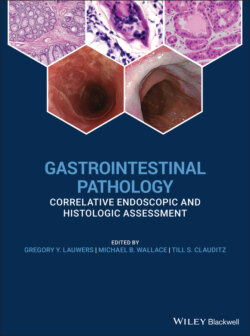Читать книгу Gastrointestinal Pathology - Группа авторов - Страница 64
Microscopic Features
ОглавлениеEsophageal biopsies are required to diagnose EOE. Eosinophils are generally absent from the esophageal squamous epithelium in normal individuals. The histologic hallmark is the presence of an increased number of eosinophils within the squamous epithelium (Figure 2.13). Although there is no exact threshold number that establishes a diagnosis, 15 eos/HPF (peak count) in at least one biopsy is considered a “minimum” threshold.
Eosinophilia may be patchy, and it is recommended that two to four biopsies from at least two locations in the esophagus should be taken to maximize diagnostic yield. The distribution of eosinophilia is important, as they may be identified in both proximal and distal biopsies or be more prominent in proximal biopsies. Practically, only intact eosinophils with visible nuclei should be counted and eosinophilic granules should not be included, although degranulated eosinophils may be a useful clue.
Other histologic findings may be present although none of these should be considered pathognomonic. These features include moderate‐marked reactive basal hyperplasia, eosinophilic microabscesses (superficial aggregates of ≥4 eosinophils), superficial layering of eosinophils, and subepithelial fibrosis. The presence of subepithelial fibrosis is also associated with eosinophils in the lamina propria and correlates with fibro‐stenotic complications of EOE, but may not be identifiable depending on biopsy depth. Other inflammatory cells, such as lymphocytes and mast cells, can also be increased. When reporting the cases, a note is useful to summarize additional relevant histologic features and to provide an overall assessment of the case based on all available biopsies (including prior biopsies, if applicable). For example, active esophagitis with intraepithelial eosinophils (peak count of # per HPF) followed by a note. When large numbers of eosinophils are present (e.g. >40 per HPF), an exact count may be difficult and it is appropriate to report the peak count as such (e.g. “peak count of >40 per HPF”).
Figure 2.13 Characteristic histology of eosinophilic esophagitis with basal cell hyperplasia, marked eosinophilic infiltrate with eosinophilic microabscesses.
